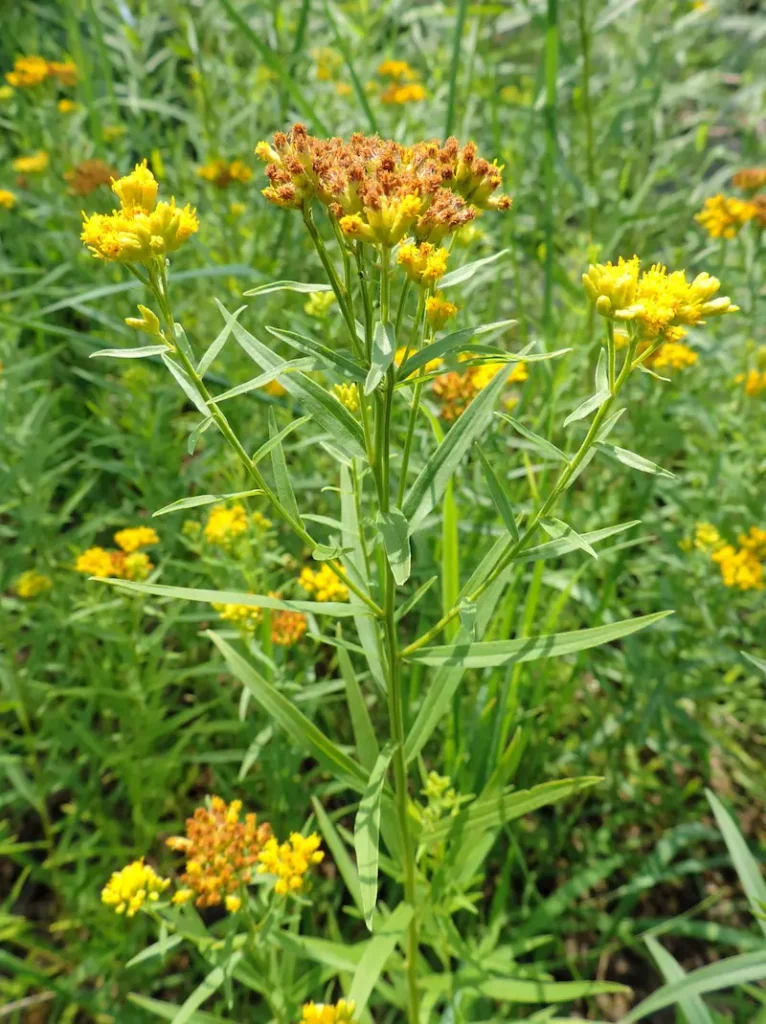Your cart is currently empty!
Wildflower and Native Plants: Are they the same?
Discover the distinction between native plants and wildflowers, and how choosing the right seeds can create a low-maintenance, biodiverse meadow garden.
Your cart is currently empty!
Grass-Leaved Goldenrod is a colourful upright perennial. The bright yellow plants are commonly seen on roadsides in rural areas, moist meadows, and sandy or moist shorelines; and are suitable for cottage gardens, borders, and meadows. They are named after their defining characteristic of having narrow leaves along their stems. It also has a rounded flat top cluster of small, shiny yellow flowers. Grass-Leaved Goldenrod is a rhizomatous, sometimes aggressive species and may not be suitable for small landscape plantings.
The small flowers attract many kinds of insects, including long-tongued bees, short-tongued bees, wasps, flies, butterflies, moths, and beetles. Various wasps and a few beetle species, such as the Goldenrod Soldier Beetle and the Black Blister Beetle, seem to be especially attracted to the flowers. The Eastern Goldfinch and Swamp Sparrow eat the seeds to a limited extent. At the same time, the foliage is occasionally consumed in limited amounts by the Cottontail rabbit and White-Tailed Deer.
Botanical Name: Euthamia graminifolia
En français: Verge d’or à feuilles de graminée
See More Plants in this Botanical Family:
Colour:
Sun / Shade:
Height:
Width:
Pollinators:
Care:
Goldenrods tend to bloom from late summer to early fall, from the months of August to October. Blooms start in mid-August and can last until early October. Goldenrods can be planted directly from their seeds or in a partially grown pot from the nursery. They can grow and spread rapidly. These bright yellow plants generally reach their peak size in about a couple of months.
Goldenrod leaves can vary greatly in size and shape, but they are generally about 10 cm long by 2 cm wide, tapering towards the tip and narrowing at the base, without a leaf stem and with some small teeth around the edges. Near the bottom of the leaf are three parallel veins, and the underside is hairy, especially along the veins, while the upper sides are rough.
Goldenrods have brown and yellow fibrous roots. Despite being large compared to its plant body, its fibrous root looks small when you grab a handful.

Goldenrod flowers have golden spikes with fluffy golden petals in various shades of yellow near the top of the plant. Their leaves range from bright to dark green in color, and their stems range from brown to green, depending on their age.
In addition to reducing pain and swelling, goldenrod also helps joint pain and arthritis and stops muscle spasms. It is necessary to dry and harvest them, and they can also be used as a natural dye for cotton and wool clothing.
Using a clean dishcloth or paper towels, spread out the flower heads. Break up any large sections with your fingers or scissors so they can air dry in a single layer. Dry the goldenrod clusters by hanging them. After drying, store in a labeled mason jar once fully dried. It may take a few days, a week, or more, depending on humidity. The color of dried herbs usually fades considerably after nine months to a year, so it’s probably past its prime if the color fades considerably.
Discover the differences among many these goldenrods.
They each have their own uniqueness.
Discover the distinction between native plants and wildflowers, and how choosing the right seeds can create a low-maintenance, biodiverse meadow garden.
Obedient plant flowers are “obedient” and bend in any direction. It is a wonderful flowering plant in the mint family that is easy to grow.
Discover how touching plants in the garden benefits sensory experiences, connects with nature, and enriches education and exploration.
Admire the stately beauty of weeping trees in your garden any time of year! Get to know our top 10 varieties for cold climates, from the Weeping Alaskan Cedar to the Weeping Colorado Spruce. Perfect for creating a peaceful focal point in your garden.
Discover the spiritual symbolism and practical uses of Japanese bridges – from their history in the Heian Period to their iconic red color. An exploration of their history, design, and spiritual impact on the Japanese garden experience.
Look at combinations of plants, colours, textures to match or complement. Use combinations of primary colours; complementary colours; analogous colours
GardeningCalendar.ca gets some funding from advertisers. If you click on links and advertisements at no cost to you, the site may receive a small commission that helps fund its operation.
© 2025 J&S Calendars Ltd.
Leave a Reply
You must be logged in to post a comment.